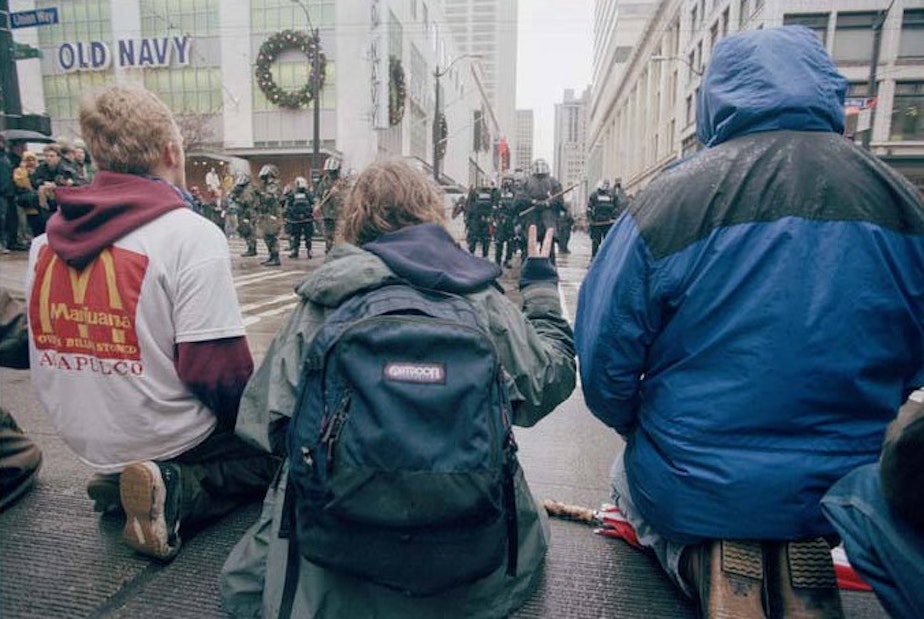A cop shot this wooden bullet at me at the WTO protests in Seattle. Here’s the story it tells

I have a wooden bullet that I sometimes show to people. It’s about the size of a jumbo marshmallow.
During the WTO protests, a police officer shot it at me.
It bounced off the wall and landed at my feet.
It didn’t hurt me. But it shattered something: a myth about what Seattle was in 1999 and what it could give to the rest of the world.
To tell the story of this bullet, I'm going to take you on a tour. It starts at the Washington State Convention Center, where the WTO conference was held back in 1999.
Back then, the convention center was still kind of small, but it was planning a massive expansion. That expansion shows where Seattle was leaning at the time.
The most recent election for mayor had pitted a pro-growth developer against a candidate who wanted to keep Seattle small.
Sponsored
The pro-growth side won.
Maybe it had something to do with the money rolling in from the dot-com boom or the job security that came with Boeing’s record-setting backlog of orders. Or maybe it was our status as a major port city, which brings in a lot of wealth.
Leonard Garfield, a historian with the Museum of History and Industry, remembers the giddiness of this time.
“We had gone through the 1990s on this joyride of success. We were becoming a huge player with the growth of the tech industry, the rise in property values, with everybody from California finding a new home in Seattle,” he said. “There seemed to be no end to the optimism and the enthusiasm of being in Seattle.”
And there was this sense among city leaders that we could have it all. We could have the benefits of globalization while remaining true to our core “northwest values.”
Sponsored
Garfield recalled the openness to all ideas common at the time.
“Not only are we mellow people who work things out, but we accommodate political views. Of course we’re in favor of free trade, it’s the progressive attitude of the 20th century. And of course we’re in favor of environmentalism. And of course we’re in favor of labor rights. And of course we’re in favor of protests and ministerial meetings," he said.
But that was naïve.
“Underneath this veneer of prosperity and progress were some very serious tensions,” said Garfield.
Seattle’s prosperity blinded us to the scale of those tensions.
Sponsored
Which bring us to the second spot on our tour: the intersection outside the Sheraton Hotel, Sixth and Pike, where protesters chained themselves together, like people used to do to protest logging operations.
Norm Stamper was the Seattle police chief at the time. He said police had made a secret agreement with protesters to make some arrests for the cameras.

"Direct Action network wanted some choreographed arrests," Stamper said. But he said the police panicked when they saw how many thousands of people were headed for downtown. And in their panic, they ditched that agreement and fired tear gas on protesters at this intersection.
It’s a decision Stamper said changed everything.
“That’s the worst mistake — the worst tactical mistake — of my career," he said.
Sponsored
"What we didn’t fully grasp was if you tear gas somebody who’s done nothing other than take a seat in the middle of the intersection, there’s a pretty good chance that when that person gets up and regroups with other people they’re going to be much more militant in the response to the police presence.”
Here’s what one protester told a KUOW reporter at the time: "This is going to make people more enraged than ever," he said. "This will never end now. Never. What they're trying to do to us, what those gendarmes against the people are trying to do is criminal beyond belief. That's my feeling. And it's not going to end, it’s going to grow. It’s going to grow and multiply!”
And it did multiply. It spread up to Capitol Hill, where I used to live.
That's the final stop on our tour: outside a Thai restaurant on Broadway.
It was a different Thai restaurant in 1999. I was eating dinner there with my wife when outside the window we saw lots and lots of people walking north carrying take out containers from other restaurants.
Sponsored
They were like a crowd fleeing the path of the monster in a Godzilla movie. And we were like, "check please!" and fled with them.
And then a giant armored vehicle, like I’d never seen before on the streets of Seattle, drove up and parked at Broadway and Roy. Police jumped out, dressed in black riot gear.
We hid in our studio apartment until a cloud of tear gas enveloped our whole block.
That’s when my friend stumbled in. He was an aspiring architect who’d been transformed into a protester. His apartment had been blocked off by police, so he’d just been wandering around and now he had a wet bandana over his mouth and toothpaste under his eyes to help with the tear gas.
He said, "I’ve got to get out there again."
I went with him. As we walked toward the police who had moved south on Broadway, I remember people were leaning out from their apartment balconies and saying, “Hey, where you going?”
And the crowd would yell back, “The police are trying to shut down Broadway. Come on!”
And that person would come out and join the crowd, which by now had grown into a massive, chaotic mess of people — each of whom was there for different reasons: environmentalists, labor activists, angry neighbors, anarchists dressed all in black.
When we arrived where the police were in front of Seattle Central College, everybody was yelling at the cops.

Which brings me back to that wooden bullet. I showed it to former police chief Stamper. “When I show this to people, they’re always shocked at the size,” I told him.
“They hear 'pellets' and they think BB’s – like a pellet gun," said Stamper, turning over the the bullet in his hands. "No! It’s a big piece of hardwood that is projected at god knows how many feet per second — and that really really hurts when it finds its target.”
Stamper apologized for the bullet. He apologized for tear gassing people. In fact, he seems to feel a personal responsibility for everything that went wrong.
He feels like he let down the cops, let down the mayor, let down the elected officials, let down the protesters.
Stamper resigned from his job over that. But in the time since, he’s became known as an expert on police reform.
In the years since WTO, he’s done a deep examination of the attitude he and other police officers sometimes hold, that is you need to dominate chaotic situations and lock them down at all costs.
“If you carry that attitude, that mentality – basically, reduced to ‘I’m the cop and you’re not,’ that attitude will create dangers and other complications that needn’t be there at all,” he said.
Stamper said if they’d just let protesters shut down the intersection for a few hours that would have been a far better outcome than what happened.
A myth about Seattle died that day; the myth that global trade and its side effects could be somehow reconciled through a big, public conversation on the streets of Seattle.
WTO brought into sharp focus how deep tensions had become related to trade and labor and the environment and policing and politics.
Those very same tensions have come to define our current era.




